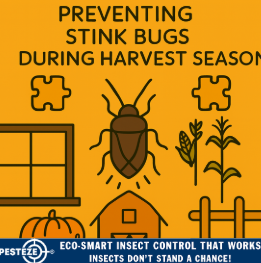PREVENTING STINK BUGS DURING HARVEST SEASON

PREVENTING STINK BUGS DURING HARVEST SEASON
SUMMARY
Stink bugs are a common nuisance during harvest season, feeding on fruits, vegetables, and crops while seeking warmth as the weather cools. Their presence can damage yields and impact both home gardens and larger farms. By using natural deterrents, proper sanitation, and preventive measures, you can protect your harvest and minimize stink bug infestations.
FEATURES
-
Harvest Promptly – Pick ripe fruits and vegetables regularly to reduce stink bug food sources.
-
Seal Entry Points – Use screens and barriers to protect storage areas and greenhouses.
-
Use Natural Repellents – Essential oils like neem, garlic, and peppermint deter stink bugs.
-
Maintain Garden Cleanliness – Remove fallen fruit, weeds, and plant debris to limit hiding spots.
-
Encourage Beneficial Predators – Birds, ladybugs, and parasitic wasps feed on stink bugs.
-
Trap Strategically – Use light traps, pheromone traps, or rolled-up newspaper to capture pests.
GUIDE DESCRIPTION
Harvest season is a critical time for gardeners and farmers, but it also attracts stink bugs in large numbers. These shield-shaped insects feed on ripening fruits and vegetables, causing pitting, discoloration, and deformation that reduce crop quality. Implementing preventive strategies early can help protect your harvest naturally.
Start with harvesting crops promptly. Stink bugs are attracted to mature fruits and vegetables, so regular picking reduces the availability of food and discourages infestations. Removing fallen or overripe produce is equally important, as these items attract and harbor pests.
Sealing entry points around storage areas, greenhouses, and sheds prevents stink bugs from entering and causing damage. Use fine mesh screens over vents and openings, and ensure doors and windows are tightly fitted.
Natural repellents such as neem oil, garlic sprays, and peppermint essential oil can be applied around garden beds and near fruiting plants. These scents repel stink bugs while remaining safe for crops, beneficial insects, and humans.
Maintaining garden cleanliness is essential. Remove weeds, plant debris, and fallen fruits, which provide hiding spots for stink bugs. Keeping the area tidy reduces shelter and decreases overall pest populations.
Encouraging beneficial predators helps maintain natural pest control. Birds, ladybugs, and parasitic wasps feed on stink bugs and their eggs, contributing to a balanced ecosystem. Planting cover crops or maintaining nearby habitats can attract these natural enemies.
For extra protection, strategic trapping can reduce populations. Light traps or pheromone traps attract stink bugs, while simple rolled-up newspapers or damp cardboard traps can catch them around garden edges. Check traps daily and dispose of captured insects away from crops.
By combining timely harvesting, sealing, natural repellents, cleanliness, predator encouragement, and trapping, you can significantly reduce stink bug damage during harvest season. These strategies protect both the quality and quantity of your produce naturally and safely.
- Shashank Rongali


Comments 0